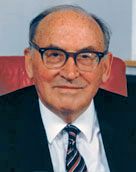| Maurice Wilkes and EDSAC |
| Written by Historian | |||
Page 1 of 2
Part of the reason for this bold development has to be accredited to the experience of high speed electronics needed to build radar systems in the war but some at least is due to men like Maurice Wilkes.
Maurice Vincent Wilkes, 1913- 2010 Early electronicsBefore the Second World War the science of electronics developed at what today would be thought of as a snail's pace. Electronics meant valves and radio. In other words, what electronic theory there was concerned itself with analog circuits. Maurice Wilkes was a keen radio amateur both at school and during his time at Cambridge where he studied maths. The type of maths he studied had a good deal of physics mixed in and it might be more accurate to call the subject applied maths or mathematical physics. Whatever you want to call the subject it was clear that its central problem was solving equations (mostly linear simultaneous or differential) to get numerical results. Hence the early interest in calculating machines. No, not the electronic sort which were many years off but instead mechanical analog machines. Wilkes saw a copy of Hartree's model differential analyser at Cambridge and realized that this could be used to solve equations to do with the propagation of long wave radio signals that interested him. Soon he was not only using the machine but looking after and encouraging others to use it. In a sense you might say that Wilkes was the first computer support person! The model differential analyser was a `model' because it was a small version of the real thing and mostly built out of Meccano parts. After showing that it worked and could solve real problems Cambridge set about getting a real machine. The Cambridge Mathematical laboratory was set up and Wilkes was employed as a demonstrator - a fairly junior post. If the Second World War hadn't come along I suppose the development of the Mathematical Lab might have been towards ever bigger and more complex differential analyzers but the world changed. Wilkes went off to work on radar and so learned a lot about high frequency electronics. More importantly he learned to think about digital electronics because radar signals could be considered to be made up of discrete pulses. This was unusual for the time and Wilkes himself comments on being amused on meeting a group of engineers who described exactly the same problems in terms of phase shift and frequency response - the language of analog electronics. Back to CambridgeAfter the war Wilkes returned to Cambridge and was appointed at the acting directory of the Mathematical Laboratory. There wasn't much to take over, however - the army still occupied the original building and Wilkes had to recruit the staff. Wilkes learned about the digital revolution going on in the USA from Hartree who described the construction of ENIAC and the working relay machine built by Howard Aitken. Having seen the power of digital electronics during the war he realized that the future was in such machines and not in the analog Meccano that was so much fun. He wrote a proposal to the Cambridge faculty saying that he thought they should do something about catching up with the head start that the Americans had in digital computers. The problem was how to catch up. America seemed much further away in 1946 than it does now and to catch up you need to know where the opposition is. Gathering intelligenceThe information that Wilkes needed came in two forms. The first was the report that Von Neumann wrote on the EDVAC. This described the stored program principle that was the next step on from the ENIAC. Wilkes recalls that because there were no such things as photocopiers he had to stay up all night to read the report before returning it to its owner! As Wilkes puts it, "I recognised this at once as the real thing, and from that time on never had any doubts as to the way computer development would go". The fact that the EDVAC report wasn't given a security classification must surely have been an oversight by some US department!
EDVAC report The second source of information was a trip to the Moore school, the acknowledged center of computer development in the USA, or the world for that matter. After struggling to get the necessary funding he attended what must have been the first computer course ever held. The big hardware problem of the time was in constructing a large enough random access memory to hold the data and the program. In principle valves could be used in the `flip-flop' arrangement that is implemented using transistors in today's static RAM chips but you need two valves per bit and hence nearly 10,000 per KByte. As a more practical alternative, mercury delay lines had been proposed but no one had built one for computer memory. A mercury delay line works by converting the electrical pulses into sound waves which travel comparatively slowly through the mercury filled tube until they are converted at the far end back into electrical pulses. Such delay lines had been used during the World War II to slow down radar pulses. To convert such a device into a memory you had to feed the pulses back into the tube so that they recirculated. It wasn't entirely obvious that this could be achieved, but when Wilkes returned to Cambridge he set about building a delay line memory - 1.5 meters long and with a delay time of 1ms. It worked after a few adjustments and Wilkes had the last piece needed to build a stored program computer.
|
|||
| Last Updated ( Friday, 06 May 2022 ) |



